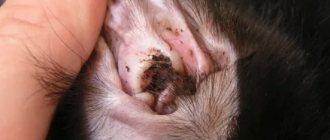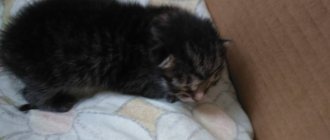Pets, cats and dogs, bring not only joy to the family, but also problems, in particular the danger of infection with parasites. Can a person get worms from a cat? - It definitely can.
Even if your pet does not leave the apartment, she can still become infected with worms, and the first person to receive such a “gift” from her will be your child. Let's figure out which worms affect cats and which of them are transmitted to humans.
What to do in such a situation? To get started, we recommend reading this article. This article describes in detail methods of controlling parasites. We also recommend that you consult a specialist. Read the article >>>
What worms do cats get?
In warm-blooded creatures, which includes us and cats, scientists have counted more than 250 varieties of parasites, but a cat can infect us with only a dozen helminths, which, however, pose a danger to the human body.
Here are just some of the types of helminths that can parasitize a cat’s body:
- Lungworms, which form cysts in the animal’s lungs, leading to the destruction of the lungs; infection occurs from open water sources and by eating crustaceans - crayfish, mollusks, crabs;
- Liver fluke, parasitizing the liver, sometimes the gallbladder and pancreas; infection through raw fish;
- Wide tape. Capable of growing up to 1.5 m, and for humans – up to 12 m; infection through river water, raw fish and crustaceans;
- Cucumber tapeworm, which attacks the intestinal wall with its sharp hooks; infection occurs through carriers - small parasites (fleas, lice eaters);
- Pathogens of alveococcosis, not dangerous for cats, but deadly for humans due to the possibility of liver tumors and metastases in internal organs; infection occurs through eaten rodents;
- Toxocara, which usually affects the intestines of animals and is especially dangerous for kittens; cause damage to vital organs in humans;
- Hookworms affecting the intestinal walls of cats; not dangerous to humans.
Infection of cats with helminths occurs in different ways:
- When eating small rodents (mice, rats);
- Through egg carriers - fleas and flies;
- Through raw fish and meat infected with helminth eggs;
- On a walk, since worm eggs are found everywhere - in the soil, in puddles, in the grass, in the sand;
- Through contact with street cats;
- Licking your fur, which contains worm eggs;
- Through your feces.
Diagnostics
Diagnosis of worms in children is carried out in different ways - depending on what worms the child is infected with, the habitat, location of the eggs, and toxins found in the body will differ.
To make a diagnosis, the following may be prescribed:
- blood test - shows anemia, hemoglobin and eosinophil levels;
- analysis for parasites - in 99% of cases it helps to detect helminthiasis, and in most cases it helps to accurately determine the type (biomaterial for research - blood from a vein);
- examination of stool - there may not be eggs in the stool, even if there is an infection, to ensure the presence of worms, this diagnosis should be carried out 3 times, which takes time;
- smear - especially effective in case of pinworm infection, since their eggs are found just outside the anus;
- stool analysis for dysbacteriosis;
- if there is a suspicion of infection of internal organs, and not just the gastrointestinal tract - CT, X-ray, ultrasound.
Diagnostics allows you to accurately identify the type of parasite and prescribe specific treatment. The doctor prescribes medications, diet, additional supportive procedures, and gives recommendations for care and hygiene.
In some cases, parents pay increased attention to helminthiasis and are constantly worried about infecting their child. This leads to regular “preventive” courses of serious anthelmintic drugs, which do not bring any benefits to the baby’s body. If your child is not losing weight, feels well, eats well, has a healthy complexion, and does not have itching in the anal area, he is likely healthy. If you want to make sure of this, it is better to get tested than to take an unnecessary course.
What worms can a person get infected from a cat?
Helminthic infestations are varied in nature, but it is important to remember that any helminth that parasitizes the body of a cat or a person deprives it of nutrients, poisons it with the toxins it secretes, and ultimately causes significant and sometimes irreparable damage, some even fatal.
A person can become infected with many types of parasites in other ways, but this often happens through contact with a pet and caring for it.
The most common types of worms that are transmitted to humans from cats belong to the classes of nematodes - roundworms and cestodes - tapeworms.
Roundworms (nematodes)
Tapeworms (cestodes)
Representatives of roundworms that are most often transmitted from cats to humans are roundworms, pinworms and toxocara. In the course of their life activity, these helminths damage the intestinal walls, often causing bleeding and, as a result, anemia; there are problems with bowel function (diarrhea/constipation); Allergic reactions may occur.
Tapeworms - cestodes include echinococcus and various types of tapeworms (bovine, pork, cucumber), which enter the animal's body when eating contaminated meat.
In humans, echinococcus causes the formation of multiple cysts in various organs, resulting in their dysfunction; pose a danger due to the possibility of perforation. Tapeworms in the human body can reach enormous sizes: for example, bovine tapeworm - up to 10-12 m or more.
Cat parasites that can be transmitted to humans include protozoa - single-celled microorganisms that cause serious diseases:
- Toxoplasmosis, which is particularly dangerous for pregnant women (due to possible damage to the fetus) and for children;
- Giardiasis, which affects the intestines and liver;
- Cryptosporidiosis, which causes extremely painful symptoms in the intestines;
- Tularemia, which affects the lymph nodes and causes an inflammatory process;
- Leptospirosis, an acute infectious disease.
And this is not a complete list of diseases caused by helminths and protozoa.
Take a test for worms
Symptoms of parasitic infestation
To prevent infection with helminths, the owner needs to monitor the health of his pet, regularly take him for examinations to a veterinary clinic, and in between, examine him himself. Absolutely all parasitic organisms do not have the goal of killing their host, because if he dies, they will have nowhere to live. But the constant lack of nutrients, the lion's share of which goes to feed the parasites, as well as the toxins released by them in the process of life, significantly weaken the body of the helminth carrier. And the symptoms of helminthic infestation are always present; a person only needs to carefully monitor the behavior and condition of his pet.
The first sign that a cat has worms is a change in appetite. The cat may refuse to eat or, conversely, constantly ask for food; it may develop unusual cravings. At the same time, the pet becomes lethargic, apathetic, and can lie for days on end, only getting up to go to the bowl.
Also symptoms of helminthic infestation are:
- digestive disorders (alternating constipation and diarrhea or one of these manifestations on an ongoing basis);
- dyspeptic symptoms;
- cough;
- discharge from the eyes;
- the appearance of allergic reactions;
- constant licking of the perineal area due to itching of the anus;
- the presence in the excrement of various impurities (blood, mucus), as well as worms visible to the eye.
If helminths have infected a kitten’s body, it may experience delayed growth and development and slow weight gain. In an adult animal, the condition of the coat deteriorates; in severe cases, convulsions and loss of coordination of movements may occur.
Your pet may complain by meowing loudly if the presence of worms causes pain or discomfort in the abdomen.
When helminths begin to actively grow and multiply, a lump of worms in the intestines causes tension and swelling of the abdomen, and an increase in its size.
If you observe such symptoms, you should immediately contact your veterinarian. He will examine the animal, determine the type of helminthic infestation and prescribe the most effective medications. A sick cat can infect both other pets and people. Therefore, measures should be taken immediately, especially if there are children in the house.
How are worms transmitted from cats to humans?
The eggs of many worms are characterized by high viability, which they are able to maintain for quite a long time in the external environment: in water, soil, sand, grass. Cats walking outside will inevitably “pick up” these eggs, become infected with worms themselves and infect their owners.
But even if the cat does not leave the apartment, it can become infected with worm eggs that are carried by the wind or that we bring on the soles of our outdoor shoes, and finally, through raw fish and animal meat. As you can see, it is almost impossible to avoid infection with worms, and this means danger for the owners.
Cats are very clean animals, they constantly lick themselves, but this only increases the risk of infection: eggs caught on the fur, when licked, directly enter its oral cavity, and then into the gastrointestinal tract, where they develop into sexually mature helminths capable of laying eggs, and in gigantic quantities, hundreds and thousands.
Thus, any contact with a cat contributes to the transmission of helminth eggs to humans: when we stroke it, kiss it, allow it to lick itself, clean the cat litter, and even just sit on the sofa or chair where the cat was lying before.
Can a child NOT become infected with worms under such conditions? Of course not, because children adore cats, love to play with them, and after that, as a rule, they do not wash their hands.
Failure to comply with personal hygiene rules is one of the main causes of helminthiasis infection, but it is impossible to imagine that all the inhabitants of an apartment thoroughly wash their hands with soap every minute. However, there are preventative methods to prevent infestation of worms from cats.
Find medications for parasites
This service is a small help in finding cures for parasites. To start using it, select the type of parasite. If you don’t know what kind of parasite you are infected with, this parasite identification tool will help you by symptoms.
Helminthiasis - a childhood disease?
Worms are often considered a childhood disease. The reason for this is that children often do not follow the simplest hygiene requirements: they do not wash their hands when coming from the street, after visiting the toilet or petting an animal, they eat dirty fruits and vegetables, and they may drink unboiled water. Kids, in addition, get to know the world by testing it by taste - they, as you know, put everything they can reach into their mouths. This is how parasite eggs enter the body.
The facts today are as follows: yes, children suffer from helminthiasis more often than adults. But this does not mean that advanced age is insurance against the penetration of worms into the body.
How to avoid getting infected and protect yourself and your family
How to avoid getting worms from a cat? First of all, you should rid your pet of parasites. The most reliable method is considered to be “worming,” that is, taking anthelmintic drugs.
It is recommended to give them to cats that walk outside once every 3 months, and to those that do not leave the apartment - once every 6 months.
To select the most effective and at the same time safe anthelmintic drug, you need to contact a veterinary clinic. “Human” medicines against worms are strictly contraindicated for animals - they can cause extremely serious consequences, including death.
Fleas are carriers of helminth eggs, so it is necessary to ensure that the animal does not have them. An anti-flea collar will help here, as well as bathing with a special anti-parasitic shampoo.
According to veterinarians, a cat should be bathed no more than 2-3 times a year (!), except in cases where it gets dirty in something.
Particular attention should be paid to the cat's litter box - it is a real accumulation of worm eggs, which they produce in huge quantities, and cats excrete along with feces. Cleaning the cat litter box should be done regularly, wearing gloves and using disinfectants.
Under no circumstances should you feed your cat raw fish and meat; they may also contain helminth eggs and larvae.
If you follow all these rules, then your pet will no longer be a source of danger for you and your children.
Medicines in the treatment of helminthic infestations
In order to determine the need to use medications, you must first consult a doctor and undergo a full diagnosis. Doctors will prescribe a series of tests that will help diagnose the type of helminthiasis. This will make it possible to select the most effective and safe medications. Self-medication in this case is completely unjustified, since anthelmintic medications are mostly very toxic and, if used incorrectly, cause serious harm.
In the treatment of helminthic infestations in humans, a variety of medications are used, which differ in their composition, spectrum of action, as well as the presence of side effects and contraindications.
Thus, levamisole can be used in the correction of ascariasis. To achieve a therapeutic effect, it is enough to take a single dose of 150 mg of the active substance once in the evening, the children's dosage is 2.5 mg per kilogram of body weight.
Levamisole can provoke a variety of side effects, among which the most common are problems in the digestive tract, represented by nausea, vomiting, diarrhea, constipation, etc.
The drug does not have many contraindications, including individual intolerance, pregnancy and breastfeeding, agranulocytosis and children under fourteen years of age. This medication is also available under the trade name Dekaris.
One of the most popular medications for helminthic lesions is Pirantel. It copes with ascariasis and enterobiasis. It is usually prescribed to take 10 mg per kilogram of body weight.
Pyrantel has few contraindications; it is not used only during pregnancy and in case of excessive sensitivity to its components. Also, the medicine can cause a minimal number of side effects, which disappear soon after therapy.
They may include nausea, vomiting, lack of appetite, diarrhea and stomach discomfort (pain).
Only a doctor can choose the appropriate medicine. And it should be used only in accordance with the instructions.
In parallel with the treatment of people, it is imperative to deworm the pet. Various drugs are used for this, but before using them it is better to consult a veterinarian.
Doctors most often prescribe Drontal to their tailed patients, and they usually recommend giving small kittens Milbemax, etc. Practicing veterinarians strongly advise using such medications once every six months - for preventive purposes.
This will help prevent transmission of the disease from cats to humans.
It is possible to defeat parasites!
Antiparasitic Complex® - Reliable and safe removal of parasites in 21 days!
- The composition includes only natural ingredients;
- Does not cause side effects;
- Absolutely safe;
- Protects the liver, heart, lungs, stomach, skin from parasites;
- Removes waste products of parasites from the body.
- Effectively destroys most types of helminths in 21 days.
There is now a preferential program for free packaging. Read expert opinion.
Read further:
Are worms contagious to humans? Can a child get infected from a cat?
What worms can you get from a cat: a list of common cat worms
More effective medications for intestinal, protozoan and other parasites in cats
Opisthorchiasis in cats: symptoms, drugs for treatment, can you get infected from a cat?
What is Streptococcus anginosus and what danger does it pose to adults and children?
What do parasitic wasps look like and do they pose a danger to people?
Prevention
Preventing infection of the owner from a cat involves measures in two areas:
- Prevention of cat diseases, consisting of regular deworming and vaccination.
- Prevention of human infection, consisting of compliance with personal hygiene requirements. Children should not be allowed to play near the cat litter box.
Most infections are transmitted by young animals to children. Such pathologies are treatable better than those that a person receives from his own kind. The satisfaction gained from communicating with fellina is not comparable to the dangers that she can bring to a person.
We invite you to join our Zen channel and group on VKontakte or Odnoklassniki, where new articles for pet owners are published.
Similar articles:
- What should you protect your pets from during the New Year holidays?
- What indoor plants can harm cats?
- What dangers do Christmas decorations pose for cats?
HOOKYLOSTOMIS
Ancylostoma tubaeforma is a hookworm, a small round helmin of the Chromadorea class, 1-2 cm long, which has two chitinous plates with three hook-shaped teeth on the oral capsule for fixation in the intestine.
Routes of infection
- Ingestion of larvae with food (feed).
- Active penetration of larvae through the skin.
- Hunting for rodents, in which the larvae can remain viable for up to 10 months.
Life cycle
Hookworm is a geohelminth
.
The eggs hatch into larvae after 10 days in the soil. If the larva enters the cat’s digestive tract with food, it quickly develops into an adult, sexually mature individual. When introduced through the skin, the larva travels a long way through the circulatory system, reaching the respiratory system and bronchi, rises up to the pharynx and is swallowed by the animal into the stomach. From them, adult individuals develop, which are attached by hooks to the intestinal wall. The hookworm is a hematotroph
- it feeds on blood. One infected cat can harbor up to several hundred hookworms. The females of the parasite lay a huge number of eggs every day, which fall into the soil with the animal’s feces.
The definitive host for Ancylostoma tubaeforma is the cat.
The paratenic host for Ancylostoma tubaeforma is rodents
Humans are not infected with this type of hookworm. Ancylostoma duodenale is pathogenic for humans.
Symptoms
The most dangerous symptom of hookworm infection is chronic blood loss with the development of anemia
. The sites of helminth penetration in the small intestine constantly bleed. With mass infestation, feces may become black (melena), and there may be profuse bleeding that threatens the life of the animal. A blood test shows a decrease in hemoglobin, the number of red blood cells and an increase in reticulocytes, as the red bone marrow tries to compensate for blood loss. In addition, the attachment of the parasite to the intestinal wall causes inflammation, which is manifested by enteritis, indigestion, diarrhea, the animal loses weight, protein-mineral metabolism is disrupted, and general health and coat condition deteriorate.
Make an appointment
The clinic offers the services of an experienced gastroenterologist, candidate or doctor of medical sciences, who will make a preliminary diagnosis, prescribe only the necessary studies according to the results of the examination, and write out a treatment plan. Having our own laboratory allows us to quickly obtain tests, and the absence of queues and appointments by appointment allows us to prescribe treatment as soon as possible. To make an appointment, select the doctor you like and fill out the form on the website, use the general appointment form, the function to order a call back, or simply call our contact center.











